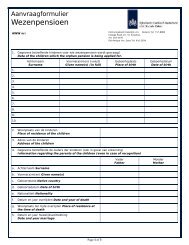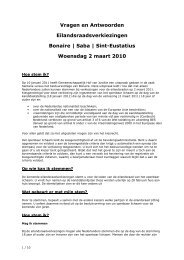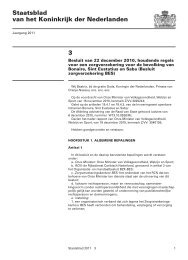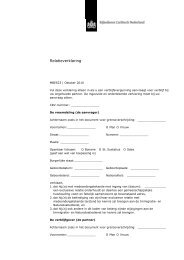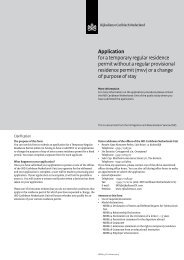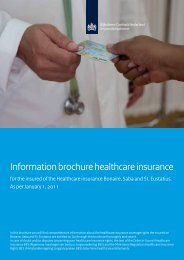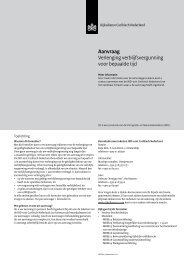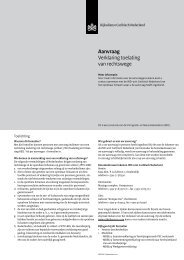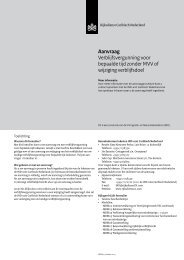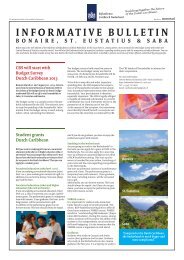here - Rijksdienst Caribisch Nederland
here - Rijksdienst Caribisch Nederland
here - Rijksdienst Caribisch Nederland
Create successful ePaper yourself
Turn your PDF publications into a flip-book with our unique Google optimized e-Paper software.
To: Peter philipsen<br />
Adviseur<br />
Fl ij kswaterstaat Noordzee I Vergun n ingverlen in g<br />
Lange Kteíweg g4IZZBB GKRijswijk<br />
Posrbus SB0Z I ZZBO HV Rijswijk<br />
25-May-2A12<br />
DNZ<br />
NR. RwgDr*z -*, /lq,<br />
2 s MEr 20t2<br />
TBffK: t//5<br />
Sjlage: ln -voud<br />
Clascificatle<br />
Dossiemr.<br />
?$"5_fFr) &< 0<br />
From: Gary Rimmey<br />
Plant Manager<br />
Cargiil Salt Bonaire<br />
Greetings Mr. philípsen<br />
ocess of the license request Íor the Cargill<br />
Marítime Management Act. The pier iga<br />
ralendijk at 1Zo North, b'S" West. The pier<br />
semi-fixed spout for loading salt.<br />
Gary Rímmey<br />
Cargtll Salt Bonaire 8.V<br />
EEA Boul|vard 117<br />
Eonaíre<br />
P.o.Box 155/355<br />
Bonalre<br />
<strong>Nederland</strong>s Antílles<br />
Tel:599 717 8341<br />
Fax: 599 717 8343<br />
info@cargíllbon.con
1. Design of the pier. T<strong>here</strong> are a lot of detail drawings, but could we have an overview<br />
drawing of the pier? The design is almost 50 years ago. Have any amendments been<br />
made to the original design? Do you have drawings of them? We may have some<br />
additional drawings of the pier saved on our computer server. I have currently<br />
requested the needed software to open those files. I will try to get back to you on this<br />
as soon as possible.<br />
2. Fire safety measures. Description indicates w<strong>here</strong> the measures are (hose on main deck<br />
and fire extinguishers on other levels). Can we get drawings that indicate w<strong>here</strong> these<br />
measures are situated? Are the measures strategically positioned? Does it have to do<br />
with (increased) risks of fire related to Salt production in certain locations? What are<br />
these risks? Is t<strong>here</strong> any risk of explosion (e.g. reaction involving the oxidation of<br />
potassium sodium tartrate by hydrogen peroxide using a cobalt salt as a catalyst). T<strong>here</strong><br />
is no risk of explosion on the pier due to the transport or movement of sodium<br />
chloride salt. We are a solar salt facility and our only product is 99% Sodium Chloride,<br />
NaCl. Additionally, t<strong>here</strong> is very little risk of loss due to fire. The pier is constructed of<br />
non-combustible concrete and steel and t<strong>here</strong> are very few combustible materials<br />
present on the pier. The pier is used solely for the loading of sodium chloride salt into<br />
bulk vessels for shipment to our customers. T<strong>here</strong> are no disporting (unloading)<br />
activities and t<strong>here</strong> are no fuel or oil bunkering activities allowed at our pier for the<br />
vessels. Those activities take place at the city pier. The safety measures discussed<br />
earlier are generally situated at the entrance/exit of each level.<br />
3. Intakes/inlets of water. Can we get a drawing and a picture of the three intakes of water<br />
and how these intakes are designed (technically)? Cargill Salt Bonaire - Intakes /<br />
Inlets. We have three intakes from the ocean. They are named the South Intake, the<br />
North Intake, and the west intake. T<strong>here</strong> are no drawings<br />
South Intake, from Cargill<br />
side, with view of ocean
South intake, Cargill side<br />
South Intake on east coast of Bonaire. Goes into Pekelmeer, eventually pumped into South flow via<br />
pump station. Approximately 17 meters wide, less than 1 meter in depth at the deepest portion.<br />
North flow, ocean side<br />
North flow, ocean side
North, flow, Cargill<br />
side.<br />
North Intake, located on east coast of Bonaire. Pipe diameter is 1.5 meters. Windmill initially used<br />
to pump water into the North flow of Cargill. During low wind conditions portable pump is used.<br />
West intake<br />
West intake, ocean side.<br />
Four 38 inch diameter pipes.
West intake, Cargill side.<br />
West intake, located on west coast of Bonaire. Currently closed. Only used a few weeks during the<br />
year doing low tide conditions.<br />
4. Are t<strong>here</strong> any outlets/sluices for the wash/ waste water? W<strong>here</strong> are they located? Near<br />
the main pumps? On land or on the shoreline? What sort of sluices are they<br />
(drawings/pictures)? The main outlet of water is on the south west side of our facility.<br />
Cargill Effluent, view on Cargill side of property. This is a view of concentrated sea<br />
water discharging from our main pump station. During this picture water from<br />
Pekelmeer (normal salinity) is flowing through the channel.
Ocean side of effluent channel. Flows into ocean on west coast of Bonaire.<br />
5. Are t<strong>here</strong> any marine archaeology findings in the vicinity of the pier? No Marine<br />
archaeology is found in the vicinity of the pier.<br />
6. Last inspection of the pier. When was the last inspection of the pier (you may have<br />
mentioned this before)? Can we get the report and the date? Global Risk Consultants<br />
(GRC) is an independent third party inspection company who is hired by our Insurance<br />
Carriers to inspect and recommend loss prevention activities to reduce risk of<br />
significant loss across the entire facility. Three separate inspections are performed on<br />
a semi-annual basis. Those inspections include an IR (infrared) scan of electrical<br />
components and rotating equipment to identify potential failures. The IR scan was<br />
last performed in December of 2011 and of course included all power distribution<br />
elements on the pier. The second inspection is Fire and Associated Perils (F&AP) and<br />
focuses on loss potential resulting from fire, natural weather events, or explosion.<br />
The next F&AP inspection is scheduled for October 16, 2012. The third inspection is<br />
Boiler and Machinery (B&M) which focuses on loss potential of critical components of<br />
the facility including the pier. This inspection was last completed in August of 2011.<br />
These reports are not for general distribution however we would be happy to share<br />
these, as well as the status of the recommendations, with you during your upcoming<br />
visit. Additionally, the pier and all other elements of the facility are subject to a<br />
monthly safety and housekeeping inspection by location personnel.<br />
7. Emergency procedures. Are t<strong>here</strong> any handling procedures/ emergency stops (e.g. if<br />
ship is full, how can the loading procedure be stopped manually, w<strong>here</strong> are the buttons<br />
involved located? Who gives the order for the emercency stop?). The vessels are<br />
loaded at a rate of 800-1500 tons per hour, depending upon the vessel size. Loaders<br />
transport the salt from the piles to a hopper which feeds salt at a controlled rate to<br />
the belt conveyor which transports the sodium chloride to the main conveyor belt<br />
which then feeds the pier conveyor belt which feeds the loading boom conveyor
which drops sodium chloride into the vessel. The entire length of all of the conveyor<br />
belts are equipped with emergency pull cables which, if pulled, will de-energize the<br />
drives in the event of an emergency. All of the conveyors are electrically interlocked,<br />
so that de-energizing of any conveyor will automatically shut off all conveyors behind<br />
it. And, all conveyors are equipped with “zero-speed switches”. Zero-speed switches<br />
sense an imbalance beteen belt movement and the drive speed. These switches will<br />
de-energize the drive if the belt is not moving at the appropriate speed. These<br />
features prevent equipment damage and significant spillage events.<br />
Additionally, the boom operator is located directly above the vessel that is being<br />
loaded, and communicates via radio with both the vessel and employees loading the<br />
salt onto the conveyor system. The boom operator controls the movement of salt<br />
from the boom conveyor onto the vessel. He has the capacity to de-energize the<br />
conveyor system at his switch board. An electrician is also on the main level of the<br />
peir during boat loading. He also serves as a secondary commmunication link<br />
between the pier and the loader operators. He can also de-energize the conveyors.<br />
Emergency<br />
shut off
Emergency shut off<br />
cable.<br />
8. Ballast water. The procedure says ‘at least’ 12 miles from the coast. Is the minimum or<br />
maximum? I remember you went to the Ballast Water convention and met Paul Hoetjes<br />
over<strong>here</strong>. What procedures are in place to handle Ballast Water issues? Bonaire has<br />
very strict rules on Ballast water. Vessels are not allowed to release ballast water in<br />
our coastal waters. Exchange has to occur outside of our 12 NM coastal limit. From<br />
what I understand our current regulations are more strict that those recommended in<br />
the Ballast Water convention.<br />
9. What happens to the impurities that are removed in the wash plants? How is and waste water<br />
discharged? Recent water quality monitoring results from the research institute IMARES in<br />
Bonaire reveal above threshold levels of NH4 and organic matter (nutrients) in the sea near the<br />
Cargill Salt facilities. Can you exclude the possibility t<strong>here</strong> is any correlation with the Cargill salt<br />
production process. The IMARES report needs to be backed up by additional testing before we<br />
can make assumptions. We are open to cooperating with the local entities to develop a suitable<br />
water quality testing program that would clarify the situation. Water from the wash plant<br />
flows through a sedimentation pond and is recycled back into our salt production<br />
system. Calcium Sulfate and Magnesium Sulfate precipitate out as a solid and that<br />
material is dredged our and is later used for on site road repairs. Occasionally<br />
concentrated sea water is released through our discharge from one of our crystallizers.<br />
This is a rare occurrence occurring about 4 times a year. The IMARES report needs to be<br />
backed up by additional testing before we can make assumptions. At this time, we have<br />
no reason to believe that we are contributing nitrates to the water off the west coast of<br />
Bonaire. We are open to cooperating with the local entities to develop a suitable water<br />
quality testing program that would clarify the situation.
Port Facility Security Plan / Manual<br />
Cargill Salt Bonaire N.V.<br />
Cargill Salt Pier
PORT FACILITY SECURITY PLAN<br />
Name of Company:<br />
Postal Address:<br />
Town/ City<br />
Cargill Salt Bonaire N.V.<br />
117 EEG Boulevard, Bonaire<br />
Bonaire, Dutch Caribbean<br />
Shore Site number: Bon 05<br />
Compiled by<br />
Name: Roland Sint Jago and Edgar Reina, 24 Aug 2004<br />
Revised June 2012, Daniel DeAnda<br />
Email:<br />
Daniel_deanda@cargill.com<br />
Phone: (599) 717 8341, Mobile (599) 796 2632<br />
Number of seagoing vessels: 100<br />
The operations at the terminal are not subject to the Risk of Major Accidents Decree (BRZO).
Cargill Salt Company Terminal, Bonaire<br />
Operated by Cargill Salt Company, the Salina Pier is a bulk salt loading facility 5 miles south of Kralendijk<br />
at 12 o 5’5” North and 68 o 17’8” West<br />
Pier Information<br />
T – head jetty with conveyor and semi-fixed spout for loading salt for Cargill<br />
Length:<br />
187.2 meters<br />
Depth alongside: 13.72 meters<br />
Maximum Loading: 2000 tons per hour<br />
5 breasting dolphins<br />
2 mooring dolphins<br />
Pilotage<br />
For all ports in Bonaire pilotage is compulsory for vessels over 50 gross tons. Service is tendered 24<br />
hours a day on ordinary weekdays, Saturdays, Sundays and holidays.<br />
General<br />
Vessels warp along berthing line, any shore labor, tugs or launches sued for warping are for vessel’s<br />
account.<br />
Holds to be clean, dry and free from rust.<br />
No water or bunkers available at berth.<br />
Stowage factor coarse salt<br />
Only clean oceanic ballast water taken from at least 12 miles off shore permitted.
Standard Risk Assessment
The port facility belongs to the terminal type Dry Bulk Non Food Terminal.<br />
Analysis of security incidents relating to terrorism.<br />
1. Damage to or destruction of the ship or the port facility (by explosive devices, sabotage,<br />
vandalism).<br />
2. Hijacking of or attack on a ship or persons on board.<br />
3. Tamper with cargo or ship’s stores.<br />
4. Tamper with essential ship equipment and systems.<br />
5. Unauthorized access or use of the ship or loading devices for the transportation of criminals and<br />
stowaways and their personal equipment.<br />
6. Smuggling weapons or equipment, including weapons of mass destruction.<br />
7. Use of the ship itself as a weapon or as a means to cause damage or destruction.<br />
Overview of assets/infrastructures susceptible to security incidents.<br />
1. Accesses, entrances, approaches, and anchorages, maneuvering and berthing areas.<br />
2. Storage areas for goods and cargo<br />
3. Loading facilities, cargo handling equipment<br />
4. Radio and telecommunication systems<br />
5. (electrical) distribution systems, computer systems<br />
6. Security and surveillance equipment and systems<br />
Overview of major security topics to reduce vulnerability<br />
1. Organization and implementation of port facility security duties.<br />
2. Communication and raising the alarm (particularly ship-port facility interface)<br />
3. Access to the port facility.<br />
4. Areas with no or restricted access.<br />
5. Monitoring the port facility.<br />
6. Cargo handling.<br />
7. Delivery of ships stores.<br />
8. Handling unaccompanied baggage.<br />
9. Testing, reviewing and amending Port Facility Security Plan.<br />
Explanatory Notes.<br />
For the dry bulk non food terminal, the bold text is most important.<br />
This type of terminal is considered low risk. Due to the perception of low risk, the possibility of<br />
smuggling weapons via ships’ stores is considered the most likely. As a result, the most important<br />
measures relate to access to the port facility and the delivery of ship’s stores.<br />
Company specific risks.
No additional risks.<br />
1. Organization and Implementation of Security Duties<br />
The aim of the requirements governing the security organization is to guarantee that:<br />
• The structure of the security organization and its relationship with local and national authorities<br />
is clearly established and safeguarded.<br />
• The tasks and responsibilities regarding security have been clearly established and<br />
communicated.<br />
• The security organization has sufficient knowledge and skills.<br />
To acquire insight into the extent to which the facility can meet the requirements a description of the<br />
security organization, the tasks and availability of instruction is provided below.<br />
Security Organization has a Port Facility Security Officer (PFSO). He reports to the plant manager and to<br />
the local authorities.<br />
The following tasks fall under the responsibility of the Port Facility Security Officer (PFSO):<br />
• The execution of a Port Facility Security Assessment (risk assessment) and the drafting of a port<br />
Facility Security Plan (PFSP).<br />
• The implementation and execution of the Port Facility Security Plan (PFSP).<br />
• The implementation lf/order to implement periodic security inspections in order to carry though<br />
improvement measures.<br />
• The updating and modifications of the Port Facility Security Plan (PFSP)<br />
• Improving security awareness at the port facility.<br />
• Responsible for adequate training of security personal.<br />
• Reporting to competent authorities in the event of security incidents.<br />
• Coordinating cooperation with the security services.<br />
• Guaranteeing the knowledge and experience level of security personal<br />
• Guaranteeing that the security equipment is in good working order.<br />
The PFSO has a qualified security organization for implementation of the security tasks in the context of<br />
the ISPS code.<br />
Use is made of a hired in private security firm with license number KVK 1356. ( Special Security Services)<br />
The total workforce of the organization is 70 employees.<br />
The staff are present around the clock.<br />
The complement of the staffing is a follows:
Staffing during office hours:<br />
4 employees<br />
Staffing during evenings:<br />
2 employees<br />
Staffing during weekends:<br />
2 employees<br />
The security services carries out the following tasks:<br />
• Entry checks<br />
• Checks on transport documents<br />
• Search of personnel<br />
• Search of visitors<br />
• Accompanying visitors and/or drivers<br />
• Guard duty surveillance of buildings<br />
• Guards duty, surveillance of site (fencing, gates, site lighting).<br />
• Surveillance of unauthorized/restricted areas<br />
• Checks on baggage<br />
• Checks on ship’s stores<br />
• Back up for operational services<br />
The security level can be scaled up if security level 2 or 3 becomes applicable. (Annex 2)<br />
Vehicles<br />
The security organization has its own vehicles. These vehicles are clearly recognizable and equipped<br />
with optical and/or sound signals.<br />
Security Incidents<br />
Security incidents are reported in an adequate manner by the company. The company has a standard<br />
form for this purpose. It is standard practice to analyze and evaluate the incidents with the aim of<br />
formulating improvement measures.<br />
2. Communication and Raising the Alarm<br />
The purpose of the measures in the communication field is:<br />
• To get the port facility and the ship to make agreements regarding cooperation in the field of<br />
security particularly in the event of a security threat or a crisis situation.<br />
• To have an early warning and evacuation plan for the port facility in the event of a security<br />
threat or disaster.<br />
• To prevent breakdown of the communication systems at the facility, t<strong>here</strong>by safeguarding<br />
communication between the port facility and the ship and guaranteeing the accessibility of<br />
external and in house emergency services.<br />
In order to achieve this, the facility has drawn up the following procedures and taken the following<br />
measures.
Procedure for Communication Ship – Port Facility<br />
T<strong>here</strong> is a procedure in place that covers communication between the Port Facility Security Officer and<br />
the Ship Security Officer regarding the communication and raising the alarm.<br />
Arrangements are in place to ensure communication between the Ship Security Officer and port facility<br />
during a security incident or disaster.<br />
An overview has been compiled, in which all means of communication present at the port facility are<br />
described.<br />
The following means of communication are employed at the port facility.<br />
• Telephone network<br />
• Mobile phones<br />
• Walkie-talkies<br />
• Email<br />
If t<strong>here</strong> is a power failure, the following means of communication still function.<br />
• Telephone network<br />
• Mobile phones<br />
• Walkie-talkies<br />
T<strong>here</strong> is an update overview of the following relevant telephone numbers for : (Annex 1)<br />
• Management<br />
• In house emergency services<br />
• Public emergency services<br />
This overview of relevant telephone numbers is also available in the Cargill Salt Bonaire Plant Emergency<br />
Action Plan. This plan is reviewed at least once a year to update the information as required.<br />
3. Access to the Port Facility<br />
The aim of the security measures covering access to the port facility is to prevent unauthorized access to<br />
the port facility. This can include access via:<br />
• Waterways<br />
• Roads<br />
• Footpaths<br />
• Piers
• Adjancent work sites<br />
Procedure Access to the Port Facility<br />
The port facility has a procedure in place that states the measures regarding access to the port facility.<br />
The procedure makes reference to the measures which must be taken if security level 2 or 3 become<br />
applicable.<br />
Perimeter barriers and access<br />
The Pier is fenced off with secure and clearly visible fencing and or barriers. All possible access points by<br />
road are adequately lockable and adequately secured. The access by water is adequately secured. All<br />
the fencing, including access points is checked regularly.<br />
Identification and Registration (when vessel is present)<br />
Identity checks on personal are performed at the access point.<br />
Identity checks on visitors/passengers are performed at the access points.<br />
Identity checks on drivers are performed at the access point.<br />
Identity checks on the ship and/or ship owner are performed.<br />
The identity of third parts in recorded in writing.<br />
The plate number of vehicles is recorded in writing.<br />
The names of ships are recorded in writing and in an electronic system.<br />
Third parties are granted access to the port facility only after establishing their identity.<br />
If an attempt is made to avoid identification and registration procedures and to enter the port facility<br />
without authority, the Port Facility Security Officer and/or the authorities are called in.<br />
The port facility does not have segregated areas for checked and unchecked visitors (passengers).<br />
On arrival at the port facility, the reason for the arrival of the vehicle is verified before access is granted.<br />
On arrival at the port facility, the reason for the arrival of a ship is verified before it moors.<br />
4. Areas with No or Restricted Access<br />
The purpose of designating areas with no or restricted access is:<br />
• To protect passengers, crew members, personnel and visitors (including visit on board a ship).<br />
• To protect the ships which use and serve the port facility.<br />
• To protect strategically sensitive areas at the port facility.<br />
• To protect security and surveillance systems.<br />
• To protect ship’s cargo, ship’s provisions and unaccompanied baggage against tampering.<br />
To this end, the Port Facility Security Plan must indicate w<strong>here</strong> the areas with no or restricted access are<br />
located at the port facility, the times of application and which security measures have been instigated to<br />
control access to them and the time spent within them.
Procedures for areas with No or Restricted Access<br />
The PFSO has a procedure for establishing all areas with no or restricted access, as well as the rules<br />
regarding checks on entry and presence which apply to these areas.<br />
T<strong>here</strong> is an overview of all areas with no or restricted access at the port facility.<br />
The following areas are identified as having restricted or no access:<br />
• Waterside and mooring areas.<br />
• Areas for utilities and telecommunications<br />
The procedure describes the different authorization levels for entry to the areas with no or restricted<br />
access<br />
The procedure provides rules for identifying those persons who are granted entry to areas with no or<br />
restricted access.<br />
The procedure contains additional measures relating to areas with no or restricted access if security<br />
level 2 or 3 taken effect<br />
Access to Ares with No or Restricted Access<br />
The areas with no or restricted access are securely closed and/or clearly marked.<br />
This barrier or marking of the restricted access is controlled by security personnel.<br />
5. Monitoring the Port Facility<br />
Procedures Monitoring the Port Facility<br />
T<strong>here</strong> is a procedure in place that describes how the port facility is monitored.<br />
This procedure complies with the various requirements set with respect to security levels 2 and 3.<br />
Lighting<br />
The lighting at the port facility complies with legal standards<br />
T<strong>here</strong> is lighting at the port facility of:<br />
• Access points<br />
• Berthing areas, quaysides and approaches<br />
• Buildings<br />
Maintenance of the lighting is organized efficiently.
Measures have been taken to ensure that the lighting at the port facility remains on to a satisfactory<br />
degree in the event of a power failure.<br />
Surveillance<br />
When monitoring the port facility, use is made of the following patrols:<br />
• On foot<br />
The surveillances take place at:<br />
• Offices and buildings<br />
• Areas with no or restricted access<br />
• Terrain (fences, entrance gates, lighting).<br />
Patrols are conducted with frequency of 3 times every 24 hours at irregular and regular intervals. The<br />
malfunctions that are notices during the patrols are recorded, incidents are registered. It is not possible<br />
to verify that the patrols have been conducted or the route taken.<br />
Alarm System<br />
The Port Facility has an alarm system to support the physical security of access to the port facility.<br />
The port facility does not have a camera monitoring system at the pier portion of the port facility.<br />
6. Handling of Cargo<br />
The aim of measures relating to cargo handing is to:<br />
• Prevent tampering with cargo<br />
• Only allow authorized cargo.<br />
• Prevent anything from being added to the cargo unseen during temporary storage.<br />
The minimum measures which are taken relate to the checking of cargo, vehicles and cargo transport<br />
units, the inspection methods used, the checking of documents, and agreement between ship and port<br />
facility regarding cargo handling.<br />
Salt is the only item loaded at the port facility. No cargo is received, Cargo is only loaded.<br />
7. Ship’s Stores<br />
The aim of the security measures relating to the delivery of ship’s stores is to prevent:<br />
• Tampering with ship’s stores<br />
• Ship’s stores from being accepted unless ordered.<br />
• Anything being added to the ship’s stores undetected.<br />
• The vehicle and the supplier from entering the location unchecked and without supervision.<br />
8. Unaccompanied Baggage<br />
The aim is to prevent
• Undesirable baggage from being admitted.<br />
• Anything being added to the baggage undetected.<br />
The port facility does not receive unaccompanied baggage.<br />
9. Divers<br />
No diving is allowed at the Cargill Salt Pier when a vessel is present within 200 meters of the port area<br />
10. Fire Prevention<br />
A type ABC fire extinguisher is found on the main level of the pier. Each level of the pier also has a<br />
water hose that is specifically used for fire prevention. The fire prevention equipment is inspected once<br />
a month. A special permit system is required to perform any type of cutting, grinding or welding on the<br />
pier.<br />
11. Emergency Response<br />
Response to emergencies include notifying the local authorities to enable a quick reaction to any<br />
problem. This includes and is not limited to the Harbor Office, Lt. Governor, Head of Customs, Fire<br />
Department, DROP, and Stinapa.<br />
Annex 1<br />
Important Contact Information ( Additional Numbers on Plant Emergency Action Plan)<br />
Local<br />
Police 911<br />
Ambulance 912<br />
Fire 911<br />
Special Security 717 8125<br />
Coast Guard 913<br />
Stinapa<br />
717 8444 (contact for environmental issues)<br />
DROB<br />
717 8130 ext 521 (contact for environmental issues)<br />
Customs (pier) 715 8593<br />
Harbor Master 717 5330 ext 535\<br />
Cargill Local
Gary Rimmey – Plant Manager: 001- 612-845-6437 in Bonaire 599 796 2169<br />
Gaby Felix – Project Manger 5999-517 0260<br />
Migarda Hermanus – Office Manager 599 795 1047<br />
Rolando Sint Jago – Production Manager 599 717 6309 or 599 796 9377<br />
Moizes De Windt – Maintenance Superindendant 599 7961617 or 5999-5101407<br />
Edgar Reina – Shop Supervisor 717 6941 or 786 2169<br />
Robby de Palm – First Aid 599 717 2908 or 599 7865472<br />
Poppy Rodriguez – Secretary 599 717 7959 or 540 2809<br />
Vurnon Cicilia-Field Supervisor 599 786 9619<br />
Daniel Deanda - EHS MANAGER 599 796 2632<br />
Annex 2<br />
Instructions for Security guards of Special Security<br />
A) before arrival of ship<br />
Security guard at pier entrance<br />
• Check breasting dolphins and walkways<br />
• Check access doors at North and South wing. They should be locked.<br />
• Check pier fenders<br />
• Check loading tower<br />
• Check conveyor belt<br />
• Check diving activities under pier and in its surroundings.<br />
Security guard at main entrance<br />
• Check head frame and surroundings<br />
• Check power transformer house and surroundings<br />
• Check if locks of head frame are in place and locked.<br />
• Check identity of all employees and visitors entering the loading pier<br />
Both guards<br />
Make sure that no diving takes place within 200 meters of the port area. Report any irregularities to the<br />
PFSO.<br />
B) During loading<br />
B1. Security level 1.<br />
Two security guards should be present. One of them stays at the entrance<br />
of the pier. The other one stays at the main entrance gate of the Cargill<br />
property.
Both guards receive a list of ship’s crew members before the start of their shift.<br />
They also receive a list of the lines handlers that work for the agent. Both also<br />
receive a clipboard with checklists, on which they note all relevant information. A<br />
copy of this spreadsheet is attached to the Port Security Plan<br />
The following duties need to be performed by the security:<br />
1) Check identity of all people entering the pier. Write down information on spread sheet.<br />
See for more details annex 5, access control.<br />
2) Check belongings of people leaving and entering the pier<br />
3) Keep an eye on the pier and the restricted areas.<br />
4) Check identity of people entering the main gate<br />
5) Do not allow non-company vehicles to enter the stockpile area.<br />
6) Check the transformer building in front of the pier<br />
7) Inform divers that diving in the pier area is forbidden<br />
B2. Security level 2<br />
Four security guards should be present. Two of them watch the entrance<br />
of the pier and the entrance gate, as under security level 1. Guard 3 stays<br />
on the loading platform of the pier. Guard 4 stays ashore in the vicinity of<br />
the pier and the transformer house<br />
1) Same procedures as security level 1<br />
2) Nobody is allowed to enter the pier or the Cargill property unless authorized by the<br />
PFSO or the plant manager<br />
3) all people entering the pier will be checked with a metal detector.<br />
4) No vehicles are allowed to use the parking lot near the pier entrance<br />
5) In case unidentified boats are observed near the pier, the authorities (police) will be<br />
informed<br />
B2. Security level 3<br />
Six security guards should be present. Two of them are stationed near the entrance of<br />
the pier and the entrance gate. Two of them stay on the loading pier, two stay ashore in<br />
the vicinity of the pier.<br />
1) all procedures for level 2 remain applicable<br />
2) No vehicle is allowed to approach the pier closer than 200 meters<br />
3) police assistance is requested to block the public road and to stop<br />
all vehicles approaching the port.
Salt Production and Vessel Loading Activities<br />
Cargill Salt Bonaire<br />
Salt Production<br />
The Salt production process is as follows: The seawater intake is located at the<br />
East Coast, w<strong>here</strong> the trade wind pushes the waves into the first lagoon called<br />
Pekelmeer. From the Pekelmeer, the water is pumped into several natural<br />
lagoons used today as condensers w<strong>here</strong> t<strong>here</strong> is strong evaporation and<br />
consequently forming by nature high salt concentration brine. When this brine<br />
reaches an adequate salinity, it is pumped into crystallizing solar salt ponds in<br />
which the salt grows by precipitation. Salt of these crystallizers is harvested with<br />
heavy equipments about once a year when a new hard layer of white salt crystals<br />
is 8 centimeters thick or more. It is loaded into trucks and transported to the<br />
wash plant w<strong>here</strong> it is washed with a mix of seawater and brine and cascaded<br />
over curved grates to remove any impurities. After washing, the salt is conveyed<br />
to a stacker that piles it up. It remains t<strong>here</strong> to dry and from t<strong>here</strong> it is loaded by<br />
conveyor belts onto ships and delivered mostly to the US for chemical, industrial<br />
and water softening applications. Salt Produced is a white crystalline solid with<br />
99.65 % purity. (Salt MSDS sheet, appendix 1).<br />
Properties<br />
Chemical<br />
Component<br />
Typical<br />
Analysis Units PPM<br />
Sodium Chloride 99.65 %<br />
Calcium 0.05 % 500<br />
Magnesium 0.01 % 100<br />
Sulfate 0.12 % 1200<br />
Surface Moisture 2.00 % 20000<br />
Water Insolubles 0.02 % 200
pier<br />
Cargill Salt Bonaire, Production Area Map
Boat Loading Activities – Salt is the only product loaded.<br />
Loaders moving salt from the stockpiles onto the conveyor belt.
Vessel moored along pier. Boom in vertical position.<br />
Boom in loading or horizontal position.<br />
Boom loading vessel at different angles.
Appendix 1<br />
Salt Chemical Properties and Material Safety Data sheet<br />
MATERIAL SAFETY DATA SHEET<br />
Date : 04/24/2007<br />
U.S. DEPARTMENT OF LABOR, Occupational Safety and Health Administration Form Approved OMB No. 1218-<br />
0072, may be used to comply with OSHA's Hazard Communication Standard 29 CFR 1910.1200<br />
SECTION I<br />
SECTION II - HAZARDOUS INGREDIENTS / IDENTITY INFORMATION<br />
Hazardous Components (Specify Identity; Common Name(s) OSHA PEL ACGIH TLV OTHER LIMITS RECOMMENDED %<br />
(Optional)<br />
Sodium Chloride (NaCl) is not considered a hazardous chemical as USC interprets the OSHA Hazard Communication<br />
Standard 29 CFR 1910.1200. The information on this form has been prepared with reasonable care. USC extends no<br />
warranties, makes no representations and assumes no responsibilities as to the accuracy or suitability of such information<br />
for application to purchaser's intended purposes of or consequences of its use.<br />
SECTION III - PHYSICAL / CHEMICAL CHARACTERISTICS<br />
Boiling Point : 1413 O C Specific Gravity (H 2 O = 1) : 2.165<br />
Vapor Pressure (mm Hg.) : 1 MM @ 855 O Melting Point : 800 O C<br />
Vapor Density (AIR = 1) : N/A Evaporation Rate (Butyl<br />
Acetate = 1) :<br />
N/A<br />
Solubility in Water :<br />
Appreciable (26.43% by<br />
weight at 20 Deg Celsuis)<br />
Appearance and Odor :<br />
White, Crystaline, Odorless<br />
Solid<br />
SECTION IV - FIRE AND EXPLOSION HAZARD DATA<br />
Flash Point (Method Used)<br />
:<br />
N/A<br />
Flammable Limits : LEL : N/A UEL : N/A
Extinguishing Media :<br />
Material is non-flammable.<br />
Use Media appropriate for<br />
surrounding materials.<br />
Special Fire Fighting<br />
Procedures :<br />
None<br />
None<br />
SECTION V - REACTIVITY DATA<br />
Stability : Stable Conditions to Avoid : None<br />
Incombatibility (Materials<br />
to Avoid):<br />
Bromine Trifluoride, Lithium<br />
Hazardous Decomposition<br />
or Byproducts :<br />
When heated to decomposition (above 1413 degree celsius) may emit toxic fumes of Na2O<br />
and Cl2.<br />
Hazardous Polymerization : May Not Occur Conditions to Avoid : None<br />
SECTION VI - HEALTH HAZARD DATA<br />
Route(s) of Entry :<br />
Eye ? Yes Inhalation ? Yes Skin ? Yes Ingestion ? Yes<br />
Health Hazards (Acute and<br />
Chronic) :<br />
Carcinogenicity ? No NTP ? No IARC Monographs ? No OSHA Regulated ? No<br />
Signs and Symptoms of<br />
Exposure :<br />
Listed Above<br />
Medical Conditions<br />
Generally Aggravated by<br />
Exposure :<br />
No Information<br />
Emergency and First Aid<br />
Procedures :<br />
Ingestion: Drink large amounts of water; Inhalation : Remove to fresh air; Skin Contact:<br />
Wash with soap and water; Eye Contact: Flush with water for 15 minutes. Get Medical<br />
Attention.<br />
SECTION VII - PRECAUTIONS FOR SAFE HANDLING AND USE<br />
Steps to be Taken in Case Material is<br />
Released or Spilled :<br />
No Special requirements - Check your state for reportable quantity<br />
requirements.<br />
Waste Disposal Method :<br />
Dispose of in accordance to local state and federal regulations.<br />
Precautions to be taken in Handling and<br />
Storing :<br />
Transport in dry equipment. Store in dry location.
Other Procedures :<br />
None.<br />
SECTION VIII - CONTROL MEASURES<br />
Respiratory Protection<br />
(Specify Type) :<br />
None Required - Nuisance dust mask for personal comfort.<br />
Ventilation : Local Exhaust Special : None<br />
Mechanical : Satisfactory Other : None<br />
Protective Gloves : Work Gloves Eye Protection : Goggles<br />
Other Protective Clothing<br />
or Equipment :<br />
None required<br />
Work / Hygienic Practices :



